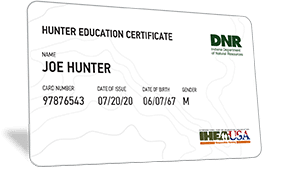
AGE REQUIREMENTS FOR INDIANA HUNTERS
Every hunter in Indiana who was born after December 31st, 1986 is required to complete Hunter Education Certification. There is no minimum age to get certified.

INDIANA HUNTING EDUCATION REQUIREMENTS
WHAT IS A INDIANA HUNTER EDUCATION CERTIFICATE
An Indiana Hunter Education Certificate proves that you’ve obtained the knowledge needed to hunt safely, responsibly, and ethically, within the state of Indiana. All hunters in Indiana who were born after December 31st, 1986 are required to get certified.
WHERE CAN I GET MY INDIANA HUNTER EDUCATION CERTIFICATE?
You can obtain your Indiana Hunter Education Certificate by completing an Indiana Department of Natural Resources (DNR) approved course. Courses can be taken either online or in-person, depending on your preference.
In-Person (Classroom) Course
Hunter Education classroom courses take a minimum of 10 hours of study and are typically held over a 2-3 day period. These courses are free and ideal for students of all ages.
Online Course:
Hunters can obtain their Hunter Education Course entirely online if they choose. Online courses typically take about 4-6 hours to complete. Students are issued a Temporary Hunter Education Certificate upon completion.
HOW OLD DO I HAVE TO BE TO GET A HUNTER EDUCATION CERTIFICATE IN INDIANA?
There is no minimum age to complete an Indiana Hunter Education Course and obtain hunter education certification.
Is my Indiana Hunter Education Certificate valid in other states?
The Indiana Hunter Education Certificate will be accepted in any US state, province, or country which also requires mandatory hunter education, meaning hunters who have obtained their Indiana Hunter Education Certificate may use it to hunt in other states. This is known as “reciprocity”.
What's the difference between a Hunter Education Certificate and a Hunting License?
A Hunter Education Certificate proves that you’ve obtained the knowledge you need to hunt safely and ethically in Indiana, and is different from a Hunting License. The Hunting Licence is similar to a permit, and is required to hunt any game animal within the state. Different licenses and permits may be required depending on which game animal is being hunted.
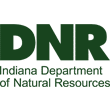
HUNTING LICENSES, STAMPS, AND PERMITS
HUNTING LICENSES
A Hunting License is required in the state of Indiana to hunt any game animal. There are a variety of license types available depending on your age, residency status, and what type of game you plan to hunt. Some of the hunting license types in Indiana include:
Resident Annual Hunting License
Annual hunting licenses are available to Indiana residents and non-residents. License fees may vary depending on residency status. Any person who was born after December 31st, 1986 must have proof of hunter education certification to purchase an annual hunting license or other hunting license types.
Deer License Bundle
A deer license bundle is a single-license that grants the order privileges to harvest two antlerless deer and one antlered deer OR three antlerless deer. The license bundle can be used during the special youth season, archery season, firearms season, and muzzleloader and special antlerless seasons
Youth Hunt/Trap Licenses
Youth hunt/trap combination licenses are available to Indiana residents who are 17 years of age or younger. There are valid for the designated hunting year, even if the youth turns 18 during that time period, however, the license must be purchased before the youth turns 18.
INDIANA HUNTER CERTIFICATION AGE REQUIREMENTS

BORN AFTER DEC. 31ST, 1986
All hunters who were born after December 31st, 1986 are required to complete a state-approved Hunter Education Course in order to purchase a hunting license in the state of Indiana. There is no minimum age to get certified.

Indiana's Hunting Fines

Hunting license violations
Up to $200

Failure to wear hunter orange
Up to $25

Unlawful taking of deer or turkey
Up to $1,000

Unlawful taking of game other than deer or turkey
Up to $35
INDIANA HUNTING FAQS
DO I NEED A HUNTING LICENSE TO HUNT WITHIN THE STATE OF INDIANA?
Yes. A Hunting License is different from a Hunter Education Certificate and is required for any person who hunts any game animal within the state. This includes both residents and non-residents. Varying licenses must be purchased and carried depending on the hunter’s age, residency, and the type of game being hunted. Certain exceptions may apply depending on the game animal being hunted. For more information on Indiana, hunting licenses visit the Indiana DNR website.
WHAT ARE THE INDIANA TAGGING REQUIREMENTS?
Certain game animals must be tagged after they’re taken, including big game animals such as deer. It’s important for hunters to understand the tagging and/or harvest reporting requirements for the game animal they’re hunting, and to ensure that the animal is tagged and reported properly.
Immediately after taking a deer, the hunter is required to complete a temporary paper tag that states their name, address, sex of the deer, and their hunting license number, in addition to the day and month of the kill.
The tag does not need to be attached to the carcass while the deer is being moved from the hunting area, and long as the hunter is carrying the tag with the required information, however, the hunter must remain with the deer at all times. If the hunter leaves the deer, the tag must be attached to the carcass.
Reporting Requirements
Any hunter who harvests a deer is required to report the harvest within 48 hours. The deer harvest can be reported via phone, or by calling 1-800-419-1236, or by finding a check station or license retailer who can enter the information through the CheckIN Game System. Upon registering the deer the hunter will be issued a confirmation.
WHAT ARE THE HUNTER ORANGE REQUIREMENTS IN INDIANA?
Hunters in Indiana are required to wear one or more clothing items in solid fluorescent orange at all times. The clothing must be worn as an outer garment and may include a vest, coat, jacket, coveralls, hat, or cap. Camouflage orange does not meet these requirements.
Hunters orange requirements apply when hunting deer, rabbit, pheasant, quail, turkey (when the fall season overlaps with firearms deer season), and squirrel when hunting from November 1st – January 31st.
WHAT ARE THE BAG LIMITS IN INDIANA?
Bag limits are imposed on hunters to restrict the number of a particular game animal that can be taken. Bag limits may be daily or seasonal depending on the type of animal. For example, daily bag limits may be imposed which restrict the number of a particular game species which may be taken per hunting day, while seasonal bag limits restrict the number of a particular game animal that may be taken by a hunter within the hunting season.
Bag limits may vary annually depending on game species populations. Hunters must understand and follow bag limit restrictions. Violations may result in fines. For more information on bag limits visit the Indiana DNR website.

GAME AND NON-GAME SPECIES
GAME SPECIES
Indiana offers a wide variety of game species for all types of hunters. Some of the state game species include:
- Big game including deer and turkey.
- Small and upland game including pheasant, quail, rabbit, snipe, squirrel, and woodcock
- Waterfowl and other migratory game birds including ducks, geese, and dove.
- Furbearers including fox, coyote, beaver, mink, muskrat, and river otter, among others.
NON-GAME SPECIES
Nongame species in Indiana make up a majority of the state’s wildlife and include mammals, birds, fish, reptiles, amphibians, and invertebrates which typically may not be hunted, are considered a nuisance, or are protected, endangered, or at risk. There is, unfortunately, a lengthy list of endangered, protected, and threatened species within the state. For more information on nongame, and endangered species within the state visit the Indiana Department of Natural Resources website.
INVASIVE SPECIES
Invasive animals and other pests have been introduced to the United States, including the State of Indiana, and have become a threat to native wildlife. These animals, plants, fish, and invertebrates typically have no natural predators which can result in the rapid spread and population growth. This in turn can seriously harm the state’s lands and waters and can be detrimental to the health and population numbers of a variety of the state’s native plants and animals. Some common invasive species in Indiana include mute swan, Asian carp, emerald ash borer, zebra mussel, and nutria, among others.
In order to protect Indiana’s native plants and animals, invasive species must be controlled and eradicated. Anyone who encounters or suspects that they have encountered an invasive species within the state is encouraged to report the sighting so that it can be monitored and controlled. For information on how to report various types of invasive species in Indiana visit the Indiana Wildlife Federation website.

INDIANA HUNTING SEASONS
Hunting seasons and dates may change annually per game animal, depending on a variety of factors. Season dates are further broken out, region or zone. Additionally, seasons are often categorized by firearm time, including archery, firearms, and muzzleloader or “primitive” firearms seasons.
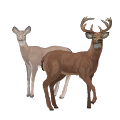
Deer
Deer seasons in Indiana are organized by firearm type, hunter age group, and hunting zone and include archery, firearms, muzzleloader, and youth seasons, in addition to a special antlerless season. The season typically opens in mid-September within “Reduction Zones” (urban zones) and closes in January of the following year at the end of the archery and special antlerless seasons.
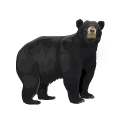
Turkey
Turkey seasons in Indiana include both spring and fall seasons, in addition to a fall-archery season and a youth season. Spring turkey season typically opens in April, and closes in Mary, while the fall season opens in October and closes in January.
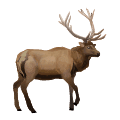
Upland Game
Upland game in Indiana includes pheasant, quail, and rabbit. Season dates vary depending on the species however, the upland game season within the state typically opens in November, and closes in February of the following calendar year.

Waterfowl
Waterfowl seasons in Indiana vary depending on the species, and hunting zone and include duck, goose and youth/veterans seasons. The season typically opens in September with goose season, and closes as late as February of the following year.
HUNTING ON PUBLIC OR PRIVATE LAND
PRIVATE LAND
Much of the land in Indiana is privately owned. Hunters can typically freely take game animals hunted on their own private property, or may seek permission from a landowner to hunt on private property. Hunters who wish to take game on privately owned land must follow state hunting regulations as well as any regulations specified by the landowner. Hunters must ensure they respect the rights and property of the landowner at all times.
PUBLIC LAND
There are millions of acres of game lands throughout the state of Indiana managed by the Indiana Department of Natural Resources. The purpose of the state owned land is to provide management of wildlife and habitat, and to provide hunting and trapping opportunities for hunters.
State managed lands may have specific rules and regulations in place that must be followed by all land users. State lands may also be used for other recreational purposes including horseback riding, snowmobiling, and bicycling.
For more information on the rules and regulations that apply to hunters and other recreational users of state lands, visit the Indiana Department of Natural Resources website.
FISH AND WILDLIFE AREAS
Hunting in Indiana’s Fish and Wildlife Areas
All of Indiana’s Fish and Wildlife Areas are open to public hunting, providing hunters with millions of acres of accessible lands. These areas encompass diverse habitats and a range of fish and wildlife species, including game animals. Fish and Wildlife Areas are managed by the Indiana DNR Division of Fish and Wildlife and ensure excellent hunting, shooting and fishing opportunities, among a variety of other opportunities for outdoor recreational activities.
For more information on Indiana’s Fish and Wildlife Areas, visit the Indiana DNR website.
Fish and Wildlife Area Regulations
Indiana’s State Fish and Wildlife Areas may have specific rules and regulations in place which apply to all recreational users, including hunters. Hunters are responsible for ensuring they are familiar with these regulations and abide by them at all times when using these properties. Some of these regulations may include:
- Safety zone and property boundary restrictions
- License and permit requirements
- Motorized vehicle restrictions
- Legal hunting hours restrictions
The Hoosier State. Ready and rarin’ to go.

Where to Hunt in Indiana
There are plenty of game species in Indiana, and plenty of space on which to hunt them. Deer, turkey, and upland game hunters will find no shortage of hunting opportunities – they just need to know where to look.
Deer hunting is a popular hunting opportunity across much of the state. To increase your odds of hunting success, head south towards Switzerland County – located west of the Big Oaks National Wildlife Refuge, and Pike County where you’ll find the Sugar Ridge Fish and Wildlife Area. Deer populations and harvest numbers have remained consistent in these areas, so your odds of making good use of your deer tags are high.
Turkeys are another popular game species throughout the state – particularly in the fall, and Switzerland County boasts high turkey populations, in addition to deer. If you’re in search of a public hunting opportunity in the area, check out the Splinter Ridge FWA, which is a known hotspot for turkey hunters in the state.